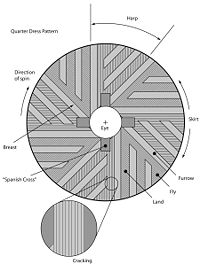
Photo from wikipedia
In this article, the methodology of using probabilistic models of the grinding tool wear process is presented. Probabilistic modeling with empirical data allowed determining the values of other important process… Click to show full abstract
In this article, the methodology of using probabilistic models of the grinding tool wear process is presented. Probabilistic modeling with empirical data allowed determining the values of other important process features. Among them, the distribution of active grains lifetime or distribution of cumulative attritious wear of the grinding grain apex could be distinguished. The results of modeling and wear analysis of grinding wheels as well as experimental results on peripheral grinding with zoned grinding wheels are presented. The analyzed grinding wheels consisted of three layers: two identical external layers with conventional structure and one internal layer containing the addition of abrasive aggregates. The external layers were profiled by chamfering the edges. As a result, their nominal surfaces were conical. The internal layer had a cylindrical shape and was designed for smoothing the surface after machining with external part. The tools were designed to increase the grinding efficiency and hence a good quality of machined surfaces could be acquired. For the experimental tests, the Ti6Al4V titanium alloy was used. It was found that the change in the shape and position of the grinding zone, as a result of volumetric wheel wear, caused a significant change in fracturing intensity. In the case of multilayer grinding tools, the wear process depends on the physical properties of each layer and their participation during machining of the workpiece. The presented methodology could be applied to a study on the machining process stages, which concerns temporary states and their variability according to the machining time.This makes it possible to reduce the cost of developing new tools dedicated to specific applications.
Journal Title: Materials
Year Published: 2022
Link to full text (if available)
Share on Social Media: Sign Up to like & get
recommendations!